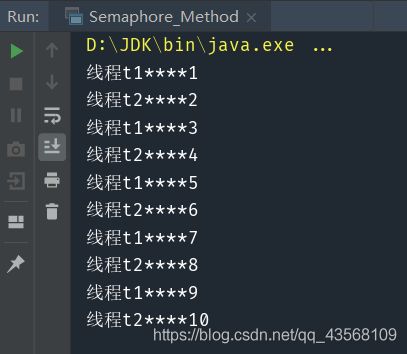两个线程交替打印奇偶数
问题描述
设计两个线程,打印1-10,一个线程打印奇数,另一个线程打印偶数,要求交替打印。 最后输出123……10
方法一(Synchronized+共享变量)
1.解题思路
新建一个对象,并定义一个共享变量。只要flag不为1,线程t2就会阻塞,释放锁资源,所以t1线程先执行,此时flag为0,跳过while判断,然后修改flag为1,打印奇数,并唤醒t2,由于flag被改为1,下次循环,t1就会阻塞。t2被唤醒后,t1已经释放了锁资源,所以t2可以获取锁资源,并且flag为1,跳过while循环,修改flag为0,打印偶数,唤醒t1。
2.代码实现
public class Synchronized_Shared_Variable {
static final Object obj = new Object();
private static int flag = 0;
public static void main(String[] args) {
Thread t1 = new Thread(() -> {
synchronized (obj) {
for (int i = 1; i <= 10; i += 2) {
while (flag != 0) {
try {
obj.wait();
} catch (Exception e) {
e.printStackTrace();
}
}
flag = 1;
System.out.println(Thread.currentThread().getName() + "****" + i);
obj.notify();
}
}
}, "线程t1");
Thread t2 = new Thread(() -> {
synchronized (obj) {
for (int i = 2; i <= 10; i += 2) {
while (flag != 1) {
try {
obj.wait();
} catch (Exception e) {
e.printStackTrace();
}
}
flag = 0;
System.out.println(Thread.currentThread().getName() + "****" + i);
obj.notify();
}
}
}, "线程t2");
t1.start();
t2.start();
}
}
3.测试
方法二(Volatile)
1.解题思路
定义一个volatile修饰的共享变量flag,当flag为false时,t2线程让出系统资源,自己进入就绪状态,让t1先执行,t1获取资源后,首先跳过while判断,打印奇数,修改flag为true,下次循环时,就会让出资源,此时t2从就绪状态进入执行状态,跳过while判断,打印偶数,修改flag为false,下次循环时,就会让出资源。如此不断交替执行,直到打印完所有奇数偶数。
2.代码实现
public class Volatile {
private static volatile boolean flag = false;
public static void main(String[] args) {
Thread t1 = new Thread(() -> {
for (int i = 1; i <= 10; i += 2) {
while (flag) {
Thread.yield();
}
System.out.println(Thread.currentThread().getName() + "****" + i);
flag = true;
}
}, "线程t1");
Thread t2 = new Thread(() -> {
for (int i = 2; i <= 10; i += 2) {
while (!flag) {
Thread.yield();
}
System.out.println(Thread.currentThread().getName() + "****" + i);
flag = false;
}
}, "线程t2");
t1.start();
t2.start();
}
}
3.测试
方法三(Semaphore)
1.解题思路
定义两个信号量,一个许可为1,一个许可为0。首先许可为0的会阻塞,所以t1线程先执行,通过s1.acquire()消耗许可,打印奇数,此时s1许可为0,t1阻塞,同时s2.release()获得一个许可,t2线程通过s2.acquire()消耗许可,打印偶数,此时s2许可又变为0,t2阻塞,同时s1.release()获得一个许可。如此反复执行,直到打印完所有的数。
2.代码实现
public class Semaphore_Method {
public static void main(String[] args) {
Semaphore s1 = new Semaphore(1);
Semaphore s2 = new Semaphore(0);
Thread t1 = new Thread(() -> {
for (int i = 1; i <= 10; i += 2) {
try {
s1.acquire();
System.out.println(Thread.currentThread().getName() + "****" + i);
s2.release();
} catch (Exception e) {
e.printStackTrace();
}
}
}, "线程t1");
Thread t2 = new Thread(() -> {
for (int i = 2; i <= 10; i += 2) {
try {
s2.acquire();
System.out.println(Thread.currentThread().getName() + "****" + i);
s1.release();
} catch (Exception e) {
e.printStackTrace();
}
}
}, "线程t2");
t1.start();
t2.start();
}
}
3.测试
方法四(ReentrantLock)
1.解题思路
首先定义一个lock和一个condition。当flag为false时,t2会阻塞,此时t1先执行,打印奇数,通过condition唤醒t2,修改flag为true,下次循环自己就会进入阻塞状态。t2被唤醒后,由于flag已经变为true,跳过while判断,打印偶数,唤醒t1,修改flag,自己阻塞,如此反复。
2.代码实现
public class ReentrantLock_Condition {
private static Lock lock = new ReentrantLock();
private static Condition condition = lock.newCondition();
private static boolean flag = false;
public static void main(String[] args) {
Thread t1 = new Thread(() -> {
for (int i = 1; i <= 10; i += 2) {
lock.lock();
while (flag) {
try {
condition.await();
} catch (Exception e) {
}
}
System.out.println(Thread.currentThread().getName() + "****" + i);
condition.signal();
flag = true;
lock.unlock();
}
}, "线程t1");
Thread t2 = new Thread(() -> {
for (int i = 2; i <= 10; i += 2) {
lock.lock();
while (!flag) {
try {
condition.await();
} catch (Exception e) {
}
}
System.out.println(Thread.currentThread().getName() + "****" + i);
condition.signal();
flag = false;
lock.unlock();
}
}, "线程t2");
t1.start();
t2.start();
}
}
3.测试
方法五(阻塞队列)
1.解题思路
定义一个阻塞队列,t2线程调用put或tranfer往队列里放数据时,会阻塞,所以t1先执行,取走之前放进来的奇数,并打印,然后将偶数put或tranfer到队列,t1阻塞,t2继续执行,如此反复执行。
2.代码实现
SynchronousQueue实现:
public class Synchronous {
public static void main(String[] args){
int[] odd={1,3,5,7,9};
int[] even={2,4,6,8,10};
SynchronousQueue<Integer> queue=new SynchronousQueue<>();
new Thread(()->{
try{
for(int i:even){
System.out.println(Thread.currentThread().getName() + "****"+queue.take());
queue.put(i);
}
}
catch(Exception e){
e.printStackTrace();
}
},"线程t1").start();
new Thread(()->{
try{
for(int i:odd){
queue.put(i);
System.out.println(Thread.currentThread().getName() + "****"+queue.take());
}
}
catch(Exception e){
e.printStackTrace();
}
},"线程t2").start();
}
}
TransferQueue实现:
public class Transfer {
public static void main(String[] args){
int[] odd={1,3,5,7,9};
int[] even={2,4,6,8,10};
TransferQueue<Integer> queue=new LinkedTransferQueue<>();
new Thread(()->{
try{
for(int i:even){
System.out.println(Thread.currentThread().getName() + "****"+queue.take());
queue.transfer(i);
}
}
catch(Exception e){
e.printStackTrace();
}
},"线程t1").start();
new Thread(()->{
try{
for(int i:odd){
queue.transfer(i);
System.out.println(Thread.currentThread().getName() + "****"+queue.take());
}
}
catch(Exception e){
e.printStackTrace();
}
},"线程t2").start();
}
}





